In this article, you’ll learn what is chassis and frame? how it works? different types of chassis used in automobile vehicles. And also download the PDF file of this article at the end of it.
Chassis and Types
The automobile vehicles both passenger car and goods trucks, are generally considered to be made up of two major assemblies:
- Chassis
- Body
So in this article, we are focusing on Chassis, Frames, and the types of chassis and frames.
What is Chassis?
The Chassis is a French word and was originally use to indicate the frame or main structure of a vehicle. And now it is use to indicate the complete vehicle except the body for the heavy vehicle having a separate body.
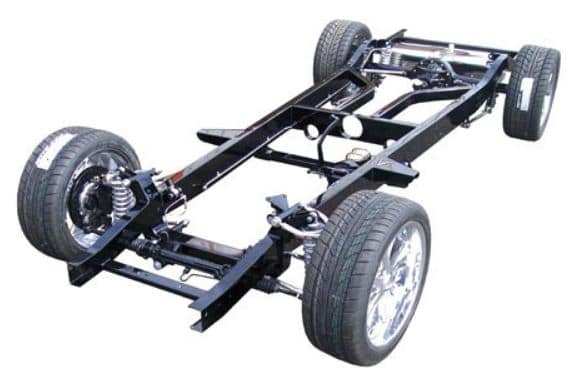
Chassis is the most important part of a vehicle and only fewer people care about it. Chassis contains all the major parts to propel the vehicle, direct its movement, stop it, and also run smoothly over uneven surfaces. It is also known as a carrying unit because all of the components are mounted on it including the body.
In this article we are not talking about which types of chassis you want to use, instead, we are looking at some of the chassis that we help you to determine the potential of your vehicle.
Types of Chassis
Following are the types of chassis according to the fitting of engine:
- Conventional Chassis
- Non-Conventional Chassis
- Full forward
- Semi forward
- Bus chassis
- Engine in front
- Engine at the center
#1 Conventional chassis
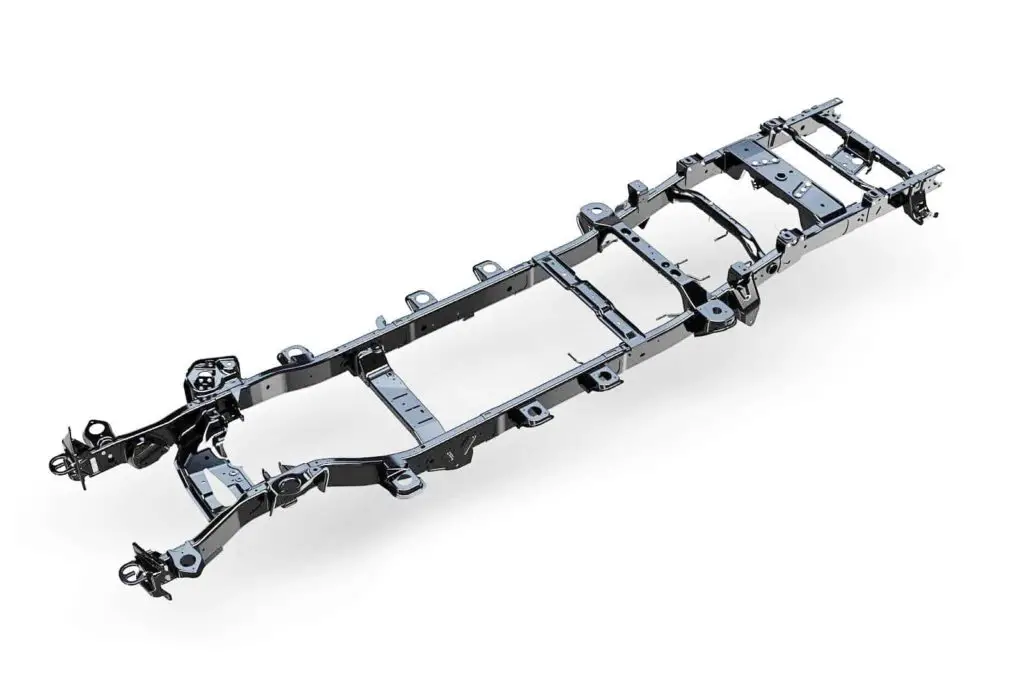
It is also known as a non-load-carrying frame. This type of conventional chassis is made as a separate unit and joined with a ladder frame. This supports all the systems like braking system, transmission system, suspension system, etc. These chassis frames are normally seen in large trucks and SUVs. Here loads on the vehicle transferred to the suspension system by frame.
#2 Non-conventional chassis
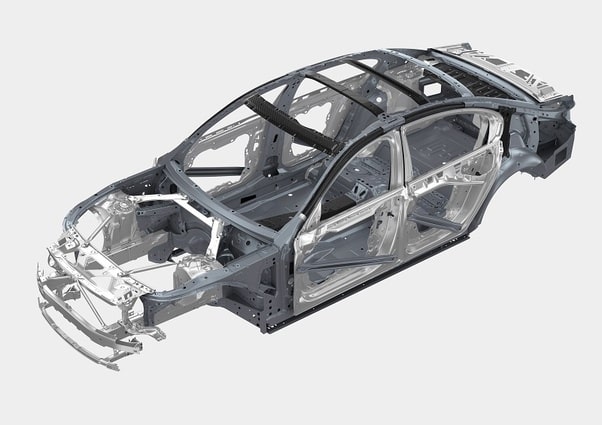
It is also known as frameless chassis or unibody chassis. This type of chassis doesn’t have a ladder frame the body itself acts as a frame. It also supports all the parts and components of the vehicles. These are mostly used on most modern vehicles just as conventional chassis.
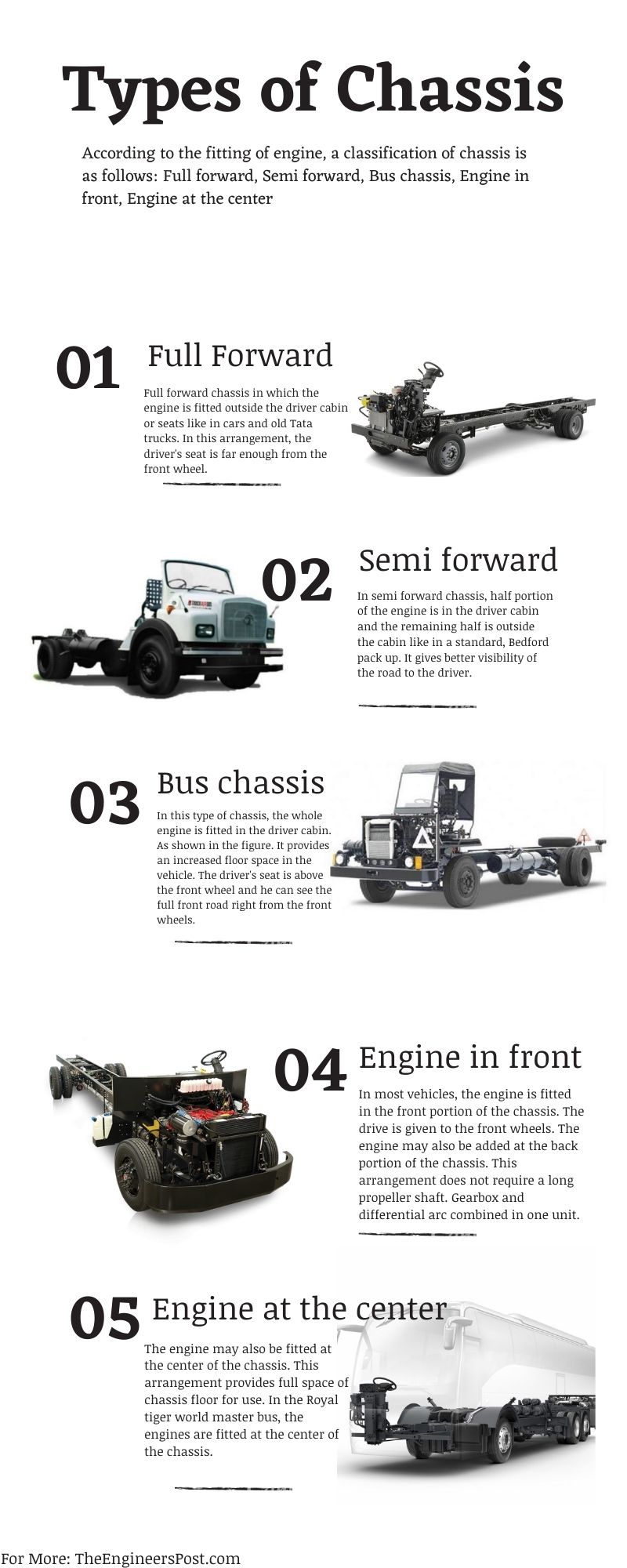
#3 Full forward chassis
Full forward chassis in which the engine is fitted outside the driver cabin or seats like in cars and old Tata trucks. In this arrangement, the driver’s seat is far enough from the front wheel.
#4 Semi forward
In this types of chassis, half portion of the engine is in the driver cabin and the other remaining half is outside of the cabin Bedford pack up. It gives better visibility of the road to the driver.
#5 Bus chassis
In this type of chassis, the whole engine is fitted in the driver cabin. As shown in the figure. It provides an increased floor space in the vehicle. The driver’s seat is above the front wheel and he can see the full front road right from the front wheels.
#6 Engine in front
In most vehicles, the engine is fitted in the front portion of the chassis. The drive is given to the front wheels. The engine may also be added at the back portion of the chassis. This arrangement does not require a long propeller shaft. Gearbox and differential arc combined in one unit.
#7 Engine at the center
The engine may also be fitted at the center of the chassis. This type of arrangement gives full space of chassis floor for use. In the Royal tiger world master bus, the engines are fitted at the center of the chassis.
What is Frame?
The frame is an important part of the chassis. All the remaining components of the chassis are mounted on it. It is a rigid structure that forms a skeleton to hold all the components together.
The engine is fixed in the front end of the frame and attaches to the clutch and transmission unit to form the power assembly. At the rear end of the frame, the rear axle is attached through the rear spring. On the steering system, some parts are bolted to the frame and some on the body. The petrol tank is fixed to the rear of the frame.
Working of the Frame
- To carry the weight of a vehicle and passengers.
- It withstand the engine and transmission torque and thrust stresses, as well as accelerating and braking torques.
- To withstand the centrifugal force while cornering.
- To withstand the bending stresses and twisting due to the. As and fall of the front and rear axles.
Types of Chassis Frames
There are three types of frames:
- Conventional Frame
- Semi-Integral Frame
- Integral or unit frame
#1 Conventional Frame
Conventional-frame is also known as non-load carrying frame. In this type of frame, the loads on the vehicle are transferred to the suspension by the frame, which is the main skeleton of the vehicle. The frame supports the engine, power train, and vehicle body. It is supported on the wheel axles by means of springs.
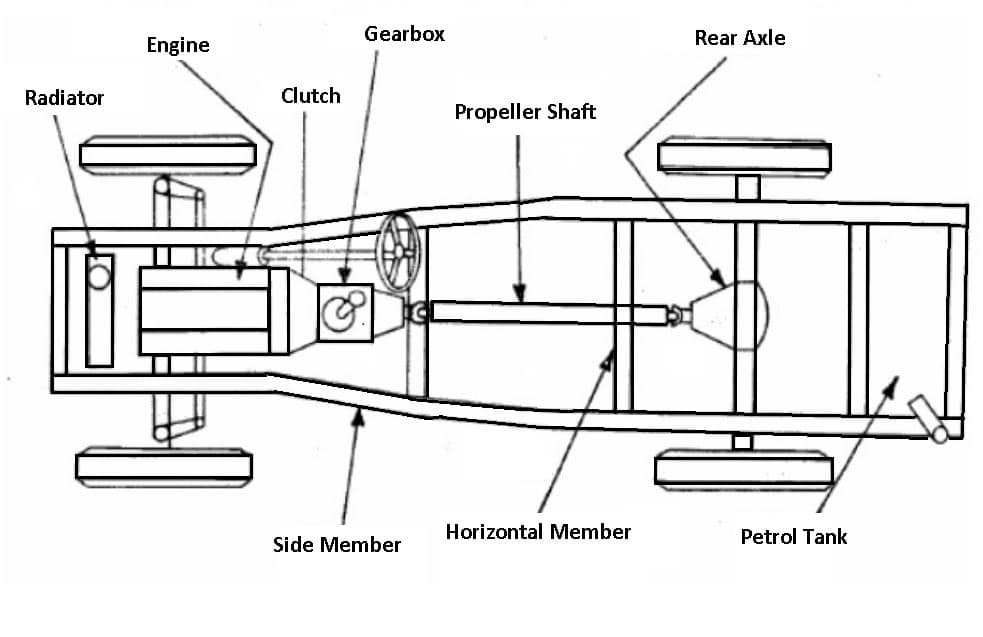
The bodywork is done by flexible material such as a wood and is completely different from frame deflection with the help of rubber mounting. This type of construction is widely used in trucks. The frame sections are normally channel, tubular, or box type. The channel frame section is good in bending, a tubular section in torsion, and a box in bending and torsion.
#2 Semi-integral frame
In the semi-integral frame, the rubber body mounts are replaced by relatively stiff mounts so that a part of the frame load is transferred to the body structure also. This type of frame is quite popular for small. European cars and American cars. is, however, heavy.
#3 Integral or unit frame
In the integral or unit frame and body type construction, there is no frame and all
assembly units are attached to the body. The body and frame is a single unit which is welded together and all the function of the frame are carried out on it.
The construction is such that the body sheets relieve the metal framework of part of the stresses. This saves some weight over the conventional separate frame and body construction.
How Frame is Made?
The frames are made by following three different steel sections:
- Channel section.
- Box section.
- Tubular section.
Channel section is employed in long members and box section is employed cross members. Tubular section is used nowadays in three-wheeler, scooters and matadores, pick-up frames. The frames should be strong enough to bear the load, sudden brakes, and accidents.
What is Sub-Frames?
The various components of a motor vehicle are bolted directly either on mainframe members or cross member of the frame. But sometimes, the engine and gearbox are carried on a sub-frame of simple construction.
The sub-frame is supported by the mainframe usually at three points. The object of this arrangement is to isolate these components from the effect of twisting and flexing of the mainframe.
That’s it, thanks for reading. I hope you like this article if yes then please share it with your friends. If you have questions about “types of chassis and frame” you can ask in the comments.
Subscribe to our newsletter to get notification of our new articles:
Download the free PDF file of this article from here.
Read More:
Prototyping of Optical Parts for Cars Is Important: Here is Why and How
External Resources:
Kindly send me notes on vehicle body work, thank you.
The PDF file has been sent to your inbox.
Hi
Hello
Plz enable pdf option
Now you can download the PDF.
Kindly send me notes on vehicle body work
The PDF file has been sent to your inbox.